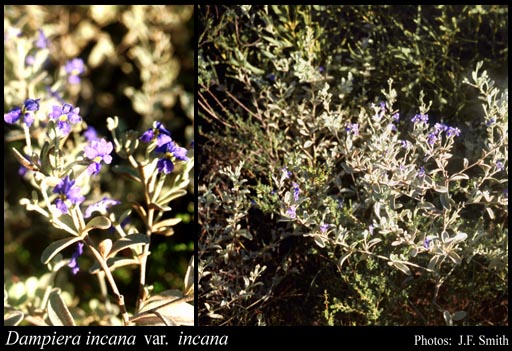- Conservation Code
- Not threatened
- Naturalised Status
- Native to Western Australia
- Name Status
- Current
Erect perennial, herb or shrub, 0.15-0.6 m high. Fl. blue, Feb or Apr to Sep or Dec. White or red sand, limestone, sandstone. Sand dunes, flats.

Scientific Description
Stems unribbed. Leaves flat, 20-50 mm long, 4-20 mm wide, Indumentum present, with dense, simple hairs; margins entire. Bracteoles present, 2.5-5 mm long, hairy, with hairy hairs. Pedicel pedicellate, Pedicel length the pedicels 1.8-2.5 mm long, Indumentum present, Hair type with dendritic hairs. Calyx lobes present, Calyx length 0-0.5 mm long, hairy, with dense, dendritic hairs. Corolla blue or purple, 9-12 mm long, auriculate, not spurred, hairy on the outside, with dense, dendritic hairs, glabrous on the inside; central lobes 3-5 mm long, with wings; outer lobes 5.5-7.5 mm long, wing present on both sides and clearly unequal, 0.4-0.5 mm wide on the narrower side, 1-1.2 mm wide on the broader side. Anthers connate. Ovary inferior, not gibbose; style 3.5-4 mm long, glabrous; indusium single, glabrous; ovules one or two. Flowers in February, September, October and November. Occurs in the Carnarvon (CAR), Geraldton Sandplains (GS) and Avon Wheatbelt (AW) IBRA Region(s), of the Eremaean (E) and South West (SW) Botanical Province.
Distribution
- IBRA Regions
- Carnarvon, Geraldton Sandplains, Yalgoo.
- IBRA Subregions
- Cape Range, Edel, Geraldton Hills, Wooramel.
- IMCRA Regions
- Central West Coast, Ningaloo, Shark Bay, Zuytdorp.
- Local Government Areas (LGAs)
- Carnarvon, Exmouth, Northampton, Shark Bay.